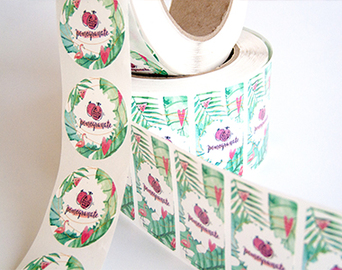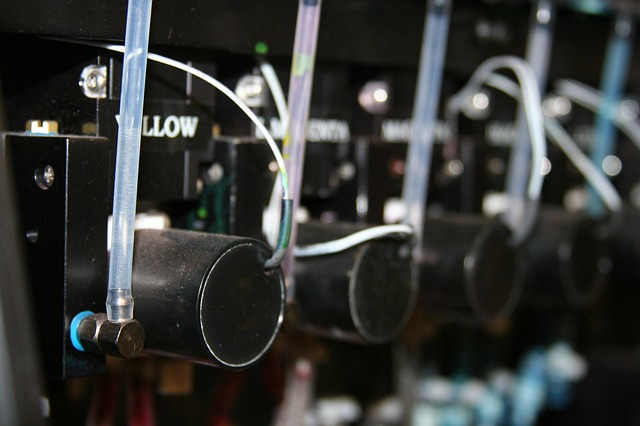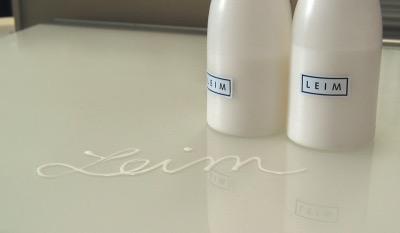
Label printing on foil and paper
 Depending on the field of application and external conditions to which the labeled product is exposed during its use, the properties of the materials used in a label printing shop differ. Therefore, the properties of the material and the correct adhesive for the labels must be determined before label printing.
Depending on the field of application and external conditions to which the labeled product is exposed during its use, the properties of the materials used in a label printing shop differ. Therefore, the properties of the material and the correct adhesive for the labels must be determined before label printing.
- Our technical advisors will be happy to help you find the right label for your product.
Self-adhesive labels from our label printing company mostly consist of three different layers:
- The surface material
- the carrier material
- and an adhesive layer in between.
These material layers are used by the manufacturer either on a roll (master roll) or as sheets. The properties of the adhesives used in a label printing company differ immensely.
In this article, you will learn more about the label printing options for film and paper labels and also find more detailed information on multi-layer labels.
1. LABEL PRINTING ON FOIL/PLASTIC
Paper labels have a clear price advantage over films. The printing paper used is wood-free, supercalendered, inexpensive, recyclable and environmentally friendly. Wood-free paper is still made of wood, but for the production of paper, the wood substances lignin and hemicellulose are filtered out by chemical processes and separated from the fiber cellulose. After filtering, the proportion of woody substances is less than 5%, which is why the paper is referred to as wood-free. Supercalendered printing paper describes a calender, a machine which smoothes paper, film, fabrics or similar with various rollers. This increases the density, smoothness and gloss of the paper. However, when it comes to weather resistance, robustness and temperature resistance of labels, film labels are more suitable than paper labels for product identification, because the surface material of film labels consists of a very thin, resistant plastic.
- If you wish, you can also have us print custom labels with your customer materials. Please do not hesitate to contact our support team.
For a label printer, label printing on smooth and non-absorbent plastic material is somewhat challenging. Most plastics used in the various label films have a "non-polar" (low-energy) and water-repellent surface to which prints adhere with great difficulty. Film labels are mostly made of the following plastics in a label printing company: Polyester (PET), Polyethylene (PE), Polypropylene (PP) and Polyvinyl Chloride (PVC).
1.1 PET labels
– ideal label printing for outdoor use
The plastic polyethylene terephthalate is obtained by polycondensation. Polyethylene terephthalate belongs to the group of polyesters. Polyester labels are adhesive labels made of polyester film.
This polyester film is very durable and especially resistant to water, gasoline, grease, oil, alcohol, acids and alkalis. Polyester is the most stable plastic material for adhesive roll labels. These labels made of polyester film (PET labels) have the great advantage of being particularly temperature-resistant. In the temperature range from -60°C to +150°C, they neither expand nor shrink.
PET labels can be used very well as a material for data and digital printing (including inkjet, laser and thermal transfer printing) due to their excellent temperature stability. They are used, for example, for type plates, in the garden market or for marking construction materials.
PET labels can be used very well as a material for data and digital printing (including inkjet, laser and thermal transfer printing) due to their excellent temperature stability. They are used, for example, for type plates, in the garden market or for marking construction materials.
Our polyester labels also benefit from these special properties. We use heat-resistant polyester for the production of PET labels, which, provided with a coating on both sides, guarantees a perfect print surface and reproduces true colors. This applies to all printing processes, from laser printers and thermal transfer printers to copiers, as they generate a lot of heat. Polyester labels are characterized by long life and excellent UV resistance. Adhesive labels made of polyester material are resistant to aging and are used wherever the marking must be reliable and maintained for many years.
1.2 PE labels
– perfect for environmentally friendly label printing
Polyethylene (PE) is an organic thermoplastic that contains no plasticizers, heavy metals or silicones and is easy to recycle. The reasons for this lie in the chemical composition of polyethylene: In the production of polyethylene, the gases propene and ethene are linked together at high temperatures, under high pressure and with the help of a catalyst to form a flexible thermoplastic.
When heated further, the thermoplastic material breaks down again into its basic components; it softens and disintegrates. A large number of everyday items that you can buy in the supermarket and elsewhere are made of polyethylene plastic. Plastic bags in the supermarket, bags for freezing food, but also conventional buckets and laundry baskets and plastic bags, and carrying cases for drinks or insulation for cables and pipe linings are made of PE plastic.
The polyethylene is an inexpensive and commonly used type of film used in a label printing company. Polyethylene does not contain sulfur, halogen or chlorine and is well suited for label printing. Polyethylene labels are easy to print and also easy to die-cut or further process after label printing. Due to their positive environmental balance, polyethylene labels are easy to recycle, toxicologically safe and insensitive to oils and greases. Polyethylene labels are ideal for labeling food or hygiene products.
PE labels are food grade and are used where some formability is required, e.g. shampoo bottles, cosmetics, detergents and flexible food packaging. Solutions of salt, various types of alkaline solutions and most non-organic acids cannot attack or degrade polyethylene. Even substances sensitive to the nose, such as nail polish remover, are packaged in bottles made of polyethene.
A specially treated PE film is used as a document film for the production of sealing labels and inspection stickers.
In order for thermal transfer printing on polyethylene labels to produce an excellent print image in all common standard and industrial printers, we recommend using thermal transfer ribbons made of resin and wax. PE labels are resistant to aging, but have low resistance to UV radiation. In addition, one should avoid exposing labels made of polyethylene to great heat, extreme cold or hot steam, as the stability of the organic plastic can no longer be guaranteed under the aforementioned extreme conditions.
1.3 PP labels
– ideal for transparent label printing
Polypropene (PP or polypropylene) is a thermoplastic that belongs to the polyolefins. This thermoplastic is formed by the chain polymerization of propene. Polypropylene is the second most important bulk plastic, accounting for about 20% of total production, and the one with the strongest growth worldwide (as of 2016). Polypropylene is naturally stronger, less easily bent, and exhibits higher transparency than polyethylene. Polypropylene plastic is also more resistant to fats, solvents, alkalis or acids than polyethylene. Due to the semi-crystalline non-polar structure of polypropylene, this plastic can be used well as a film for label printing.
Thanks to its particularly brilliant transparency, PP film is frequently used in label printing as a laminating film or for PP labels in the so-called "no-label look", for example for plastic and glass packaging. Polypropene labels can be used, for example, for non-deformable packaging of motor oils, cosmetics or household products. Polypropylene labels are therefore more suitable for outdoor use than polyethylene labels (PE labels).
Although PP labels are similar to PE labels in terms of chemical structure, labels made of polypropylene are significantly harder, stronger and more thermally resistant. The reason for this is an additional methyl group. This improves the mechanical properties and thermal resistance of PP labels, while reducing the chemical resistance of the thermosensitive label material. Polypropylene labels are also ideally suited for thermal transfer printing, as an excellent print image can be seen on their surface.
In addition to PP labels, packaging films and rigid packaging such as transparent cups or cans are other important areas of application for the plastic polypropylene.
1.4 PVC labels
– Label printing for different surfaces
PVC (polyvinyl chloride) is a thermoplastic material and belongs to the thermoplastic polymers like PE (polyethylene) and PP (polypropylene). Polyvinyl chloride can be purchased in various degrees of hardness, colors and material thicknesses and is used in many business sectors and industries. Rigid PVC is mostly used in window construction for profiles and sound panels. The soft PVC is used as flooring, or for the sheathing of cables.
Polyvinyl chloride is a plastic that is also used as flexible PVC for the production of PVC labels. The addition of plasticizers gives the naturally hard and brittle plastic plastic properties such as flexibility, crack resistance and softness. PVC labels conform perfectly to any surface and are particularly tear-resistant and conformable. Labels made of polyvinyl chloride are popularly used as chemical labels, as they have a high degree of resistance to acids, oil and seawater, and thus do not rot. PVC labels are not decomposed by sunlight and are electrically non-conductive. Polyvinyl chloride labels are resistant to water, oil, alkalis, UV radiation and adhere securely at temperatures from -40°C to +80°C. So are very suitable for sticking on curves and edges and are also suitable for uneven surface.
The use of polyvinyl chloride labels is very versatile. Due to their good weather resistance, PVC labels are very popular for outdoor use, but also as high-quality and durable labels for equipment identification, as warning labels, barcode labels or for cable identification. PVC labels are mainly used for durable products, such as weatherproof outdoor labels or loop labels in garden markets and nurseries.
Labels made of polyvinyl chloride, without an additional barrier layer, are not suitable for food labels, as the plasticizers have the property of migrating into the environment. The substances emanating from the soft PVC (plastic odors) and possibly harmful to health must not come into contact with food. Plasticizers such as flexible PVC are readily absorbed, especially by fats and oils. PP labels made of polypropylene and PE labels made of polyethylene are therefore used in the food sector.
- Learn more about chemistry labels from foil
- Discover multilayer labels in all variations
Further information outside of label printing on PE material and other bulk plastics can also be found at this link.
Click here to go directly to the materials for foil labels.
2. LABEL PRINTING ON PAPER
 Thanks to its physical properties such as gloss, writability, porosity and air permeability, label paper can be printed in excellent quality during label printing, processed easily and recycled well. Paper is a renewable natural product and therefore quite inexpensive for label printing. However, label paper has the disadvantage of being very sensitive to liquids, oils, greases, light and mechanical stress (tears and pulls). The production and finishing of a paper label determines its longevity.
Thanks to its physical properties such as gloss, writability, porosity and air permeability, label paper can be printed in excellent quality during label printing, processed easily and recycled well. Paper is a renewable natural product and therefore quite inexpensive for label printing. However, label paper has the disadvantage of being very sensitive to liquids, oils, greases, light and mechanical stress (tears and pulls). The production and finishing of a paper label determines its longevity.
Thanks to its physical properties such as gloss, writability, porosity and air permeability, label paper can be printed in excellent quality during label printing, processed easily and recycled well. Paper is a renewable natural product and therefore quite inexpensive for label printing. However, label paper has the disadvantage of being very sensitive to liquids, oils, greases, light and mechanical stress (tears and pulls). The production and finishing of a paper label determines its longevity.
For both variants, our label printing company offers already coated paper with a matte or glossy surface, which you can select when ordering in the online store. There you will also find metallized and fluorescent papers, which guarantee a greatly increased visual conspicuity of your adhesive labels. Labels printed from this paper are often used as price labels or special offer labels.
Specialty papers for label printing:In the thermal printing process, thermal paper is a very special type of paper. The adhesive labels are provided with a temperature-sensitive layer on the side to be printed, which forms a dye, mostly black, under the influence of heat. Everyone knows this paper from the supermarket checkout or the fruit and vegetable scales. For admission tickets, vouchers, tickets and lottery receipts, stronger grades of thermal paper are used for label printing. The thicker paper, which has a higher tolerance to mechanical stress, means that the quality of the printed image is retained for longer.
A special case among the paper grades for label printing are papers with high opacity, i.e. with low transparency. Opaque papers are found, for example, as package inserts in medicine packaging or for opaque labels, for example for gluing over shipping labels, such as the return label enclosed with every Zalando delivery. This high opacity is produced by adding fillers or by a higher wood content (lignin). Visible light and UV light are almost completely absorbed by this material.
Click here to go directly to the materials for paper labels.
3. MATERIALS AND ADHESIVES

The range of label adhesives is just as broad as the possible applications for self-adhesive labels and booklet labels. If we start from the adhesive properties, pressure-sensitive adhesives for adhesive labels can be divided into two different groups. Firstly, label printers speak of permanent adhesion and secondly of removable adhesion. A combination of both are so-called semi-permanent pressure-sensitive adhesives, which are initially easy to remove, but later adhere firmly to certain materials. For the adhesive strength of "removable labels", adhesive force limits of 3 N/25 mm (equivalent to 1.2 N/10 mm) are standard market practice. For permanently adhesive labels, the specified adhesive forces are 9 N/25 mm (equivalent to 3.6 N/10 mm).
Preliminary considerations for the right choice of material in the label print shop result from the external conditions under which the finished labels will later be affixed. Is it a moist or dry environment? Is the surface smooth or rather rough? Is it cold frozen goods or hot product packaging, as is usually encountered in food production or bakeries?
3.1 Surface material for label printing
The surface material is the first layer of a label. This layer is printed with a motif during label printing and can then be lacquered, laminated or given other finishes. When choosing a label material, the following questions are particularly important and should be carefully thought through before label printing:
- To which products is the label applied?
- At what temperature is the product subsequently stored?
- Is it exposed to moisture, chemicals, oils or greases?
- How much space is needed on the label?
Once these questions have been answered, it's time to select the most suitable material for your label printing. Although there are also labels made of cardboard, non-woven, leather, textile material or aluminum foil, the vast majority of self-adhesive labels are made of label paper or plastic films or a combination of these two substrates.
And finally, labels can be divided into wet glue labels or self-adhesive labels according to the technique of application. Whereas in the case of self-adhesive labels the label glue is already on the reverse side of the label material before the label is printed, wet-glue labels only have label glue applied to them shortly before they are glued on. This gluing technique is frequently used as cold glue or hot glue labeling for product labeling of beverage bottles, wines, spirits, or cans.
3.2 Vegan and environmentally friendly adhesives
While bone glue was often used in the past to adhere wet glue labels, most organic food manufacturers have now switched to a glue containing casein. Casein is a protein mixture derived from milk. It is used as a food, binder and pharmaceutical excipient. Glue containing casein is often used in returnable packaging such as glass bottles.
An alternative to casein is vegetable starch. Some manufacturers of vegan products use a starch-based adhesive instead of synthetic adhesives, which is considered 100% vegan. However, starch-based adhesives are more difficult to handle.
Labels attached with starch adhesive often curl or fall off completely. The subsequent, automated removal of labels and adhesive residues from glass containers is also more difficult and costly than with casein. Fully synthetic label adhesives adhere significantly better than starch adhesives, although not quite as well as casein.3.3 Self-adhesive labeling after label printing
Self-adhesive labeling is now being used more and more frequently for many product labels in all sectors, including beverage and food packaging. In addition to the cost savings due to the elimination of label containers and pallet sets, the high print and adhesive quality as well as the possibility of using labels in the modern no-label look should be mentioned as plus points here.
- Here you can find information about industrial labels and special labels from labelprint24.
These articles may also interest you:

Blitzer when printing labels
After the labels have been printed, the adhesive labels are punched out of the roll of material using a cutting die or a laser punch. If the print motif is to end exactly on the edge of the label, small white edges may appear - the so-called flashes.

Printing low migration labels - part 1
More than 95% of all foodstuffs sold in Germany are already packaged. For cost reasons and in response to consumer demand, an ever larger proportion has to make do without additional film bags and with a small packaging sleeve.

Etikettendruckerei Deutschland - Labelprint24
We, Labelprint24 are one of the leading German e-commerce specialists for labels and many other packaging products. In the printing industry, we have earned an image as one of Germany's most innovative label manufacturers.








 Roll labels request form
Roll labels request form  Booklet labels request form
Booklet labels request form  Folding boxes request form
Folding boxes request form  Custom made shipping boxes request form
Custom made shipping boxes request form  Package leaflets request form
Package leaflets request form  Laminate tubes request form
Laminate tubes request form 



















